Y8 Game - Info Travel - CS5 Tutorial - Free Game - Funny collection
----------------------------------------------------------------------------------------------------------------------------
----------------------------------------------------------------------------------------------------------------------------
How To Create An Abstract Floral Explosion in Photoshop
http://cs5tutorial.net/how-to-create-an-abstract-floral-explosion-in-photoshop/

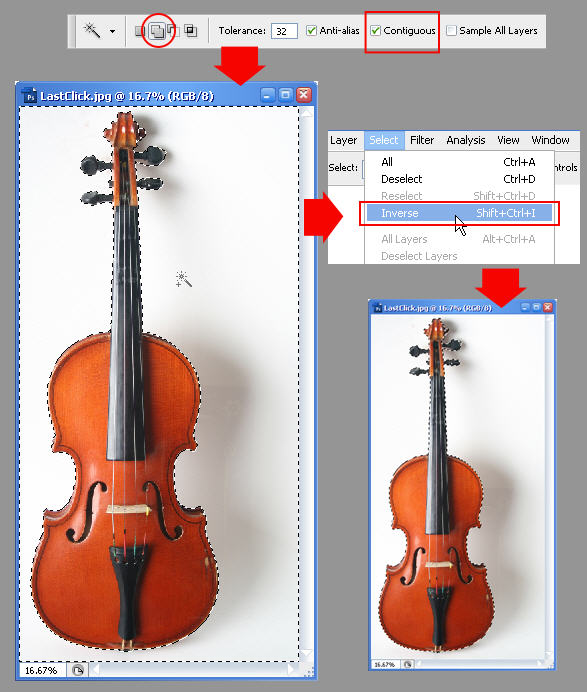 Press Ctrl+C to copy the violin (which is now selected), and then paste ( Ctr+V ) it to the document we created before. Adjust the size by using Free Transform Command (Press Ctrl+T).
Press Ctrl+C to copy the violin (which is now selected), and then paste ( Ctr+V ) it to the document we created before. Adjust the size by using Free Transform Command (Press Ctrl+T).
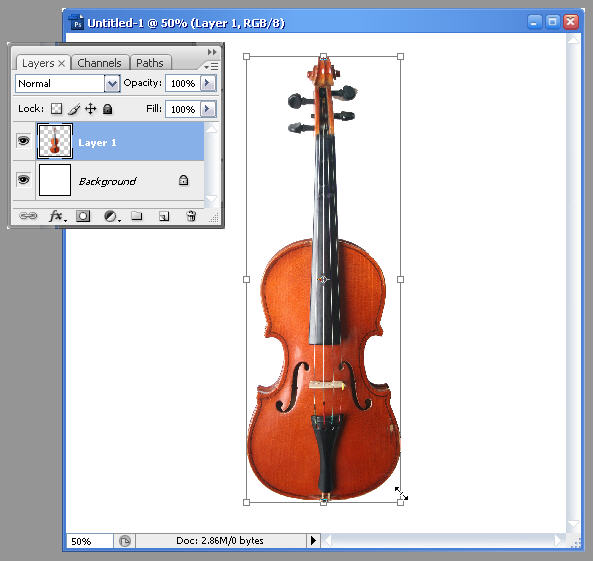
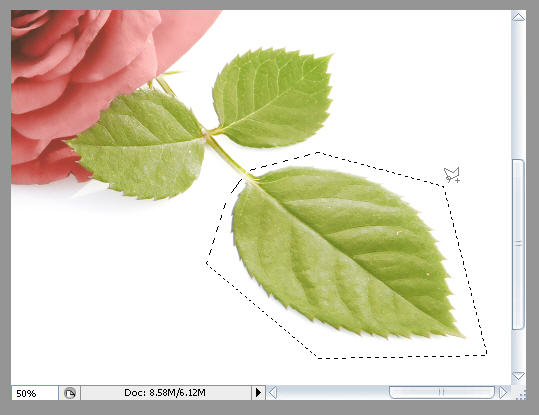 When you’re done with selection, copy and paste leaf image over the violin’s layer in the other document. Clear the white color around the leaf by using Magic Wand tool (just click the white color and then press Delete). Deselect by pressing Ctrl+D.
When you’re done with selection, copy and paste leaf image over the violin’s layer in the other document. Clear the white color around the leaf by using Magic Wand tool (just click the white color and then press Delete). Deselect by pressing Ctrl+D.
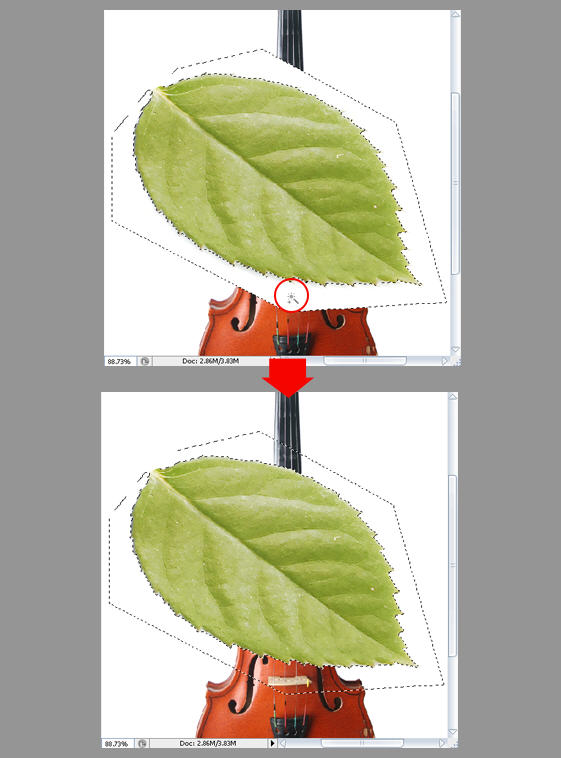 Drag the leaf layer (Layer 2) below violin’s layer (Layer 1). Using Free Transform command (Ctrl+T), adjust the size and rotate it to right a bit. Press Enter when you’re done.
Drag the leaf layer (Layer 2) below violin’s layer (Layer 1). Using Free Transform command (Ctrl+T), adjust the size and rotate it to right a bit. Press Enter when you’re done.
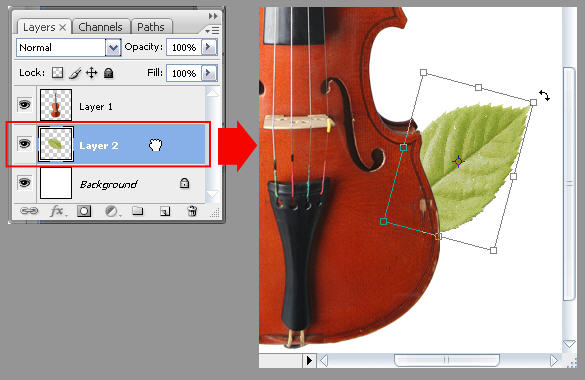
Select the violin layer, then press Ctrl+L to bring up the Levels dialog. Adjust Input Levels valueas shown below to increase the contrast. Click OK when done.
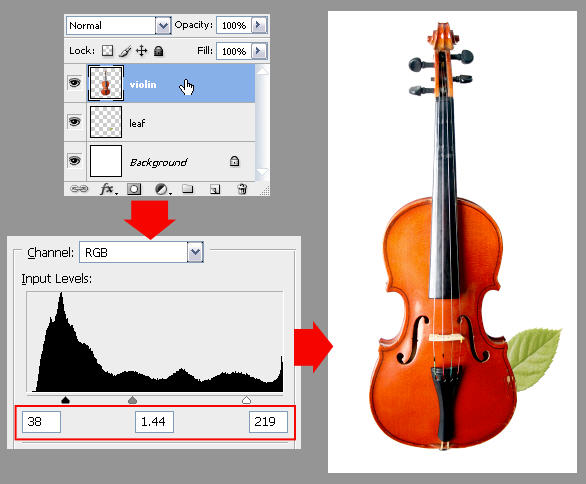 Activate the leaf layer, use the Levels command to make increase the leaf’s contrast. Then use Hue/Saturation (Ctrl+ U) command to adjust leaf’s color to make the greens more vibrant, green, and saturated. See image below for details.
Activate the leaf layer, use the Levels command to make increase the leaf’s contrast. Then use Hue/Saturation (Ctrl+ U) command to adjust leaf’s color to make the greens more vibrant, green, and saturated. See image below for details.

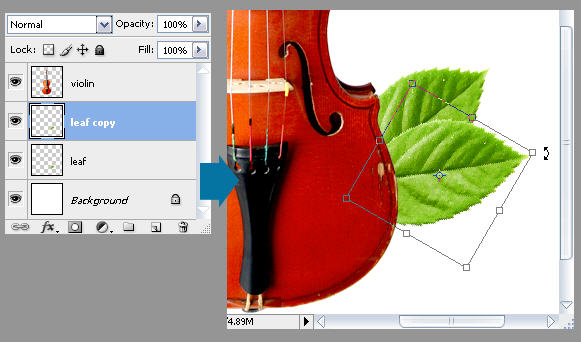 Repeat this duplicating process until you get 5 leaf layers. Play around with the size, rotation and position of each leaf layers until you get a very nice layout. Remember, we’re using the Free Transform function, so be sure to touch up on the Transform functions if you’re having trouble.
Repeat this duplicating process until you get 5 leaf layers. Play around with the size, rotation and position of each leaf layers until you get a very nice layout. Remember, we’re using the Free Transform function, so be sure to touch up on the Transform functions if you’re having trouble.
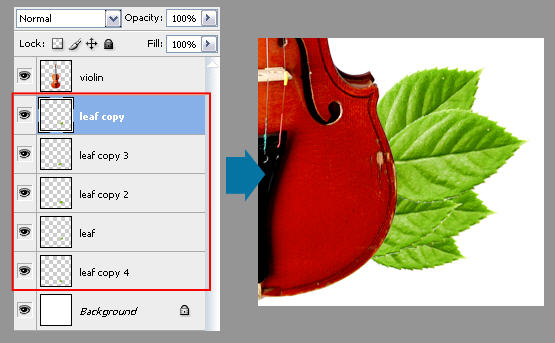
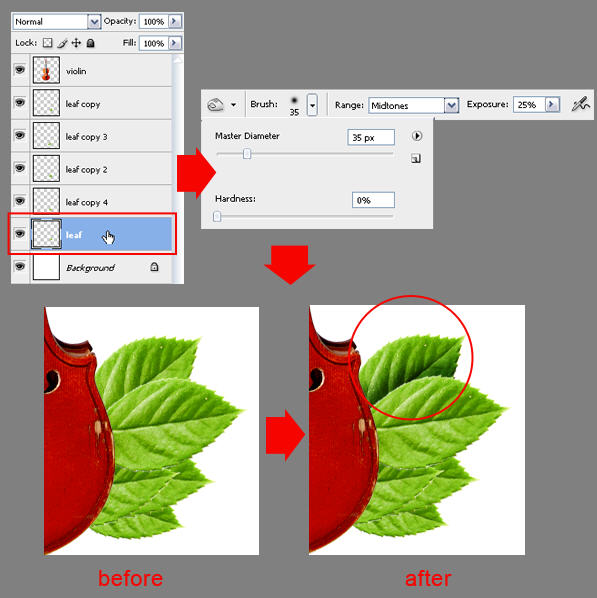 Now we need to make highlights using the Dodge tool. Make sure you pick a soft round brush and reduce the Exposure value to 25% when doing this.
Now we need to make highlights using the Dodge tool. Make sure you pick a soft round brush and reduce the Exposure value to 25% when doing this.
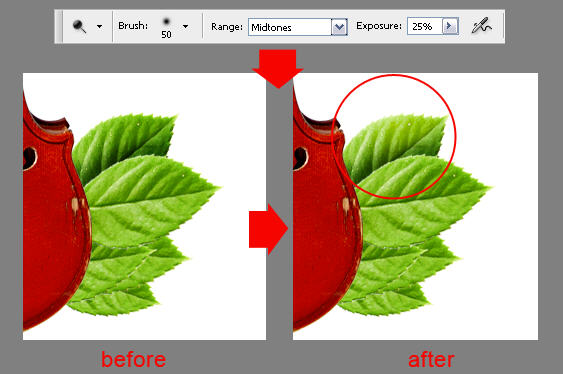 Repeat this process for all of the leaves layer. You should be end with leafs that have much more depth than when we began.
Repeat this process for all of the leaves layer. You should be end with leafs that have much more depth than when we began.
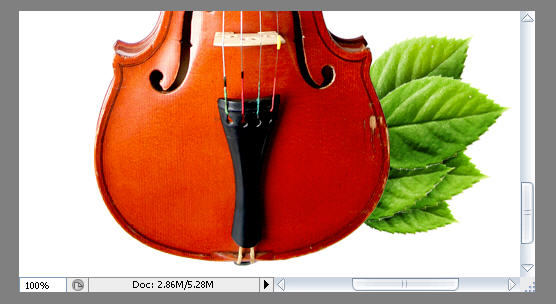
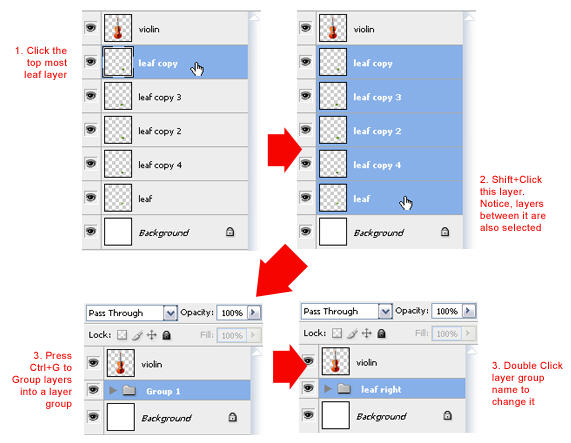 Now we’re going to balance the composition by duplicated the leaves on the right of the violin to show on the left as well. Rather than starting from scratch, you can just duplicate the group we just created by right clicking on the leaf right layer group, then choosing Duplicate Group from the popup menu.
Now we’re going to balance the composition by duplicated the leaves on the right of the violin to show on the left as well. Rather than starting from scratch, you can just duplicate the group we just created by right clicking on the leaf right layer group, then choosing Duplicate Group from the popup menu.
Name the layer group duplicate’s: leaf left. With the layer group leaf left still selected, click menu Edit> Transform> Flip Horizontal, all leaf layers should be flipped to the left now. Using the Move tool, drag the layer group leaf left so the leaves are positioned on the violin’s left side.
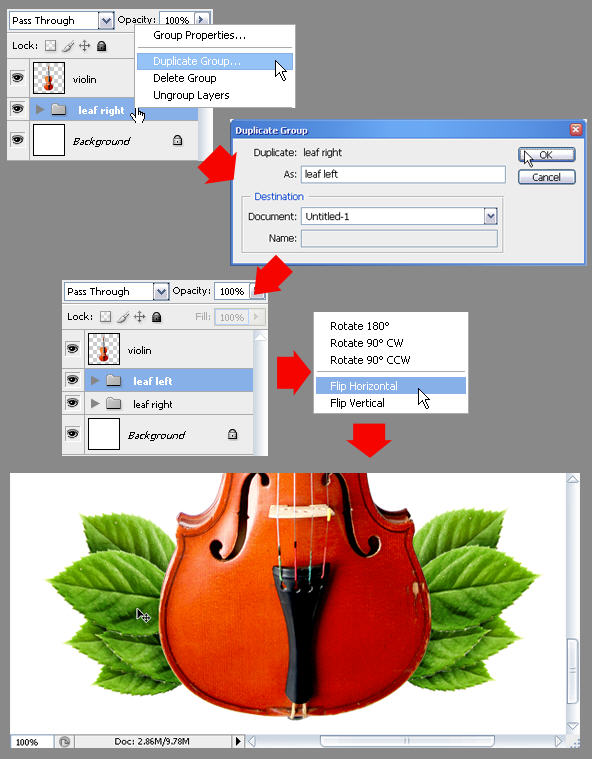
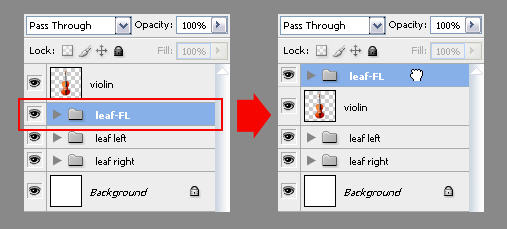 Re-arrange the leaves using Move tool and Free Transform command. Try to make the leaves’s layout like the one below. Because the leaves are different from before, you should re-define the shadow and highlight area of each leave. Use Dodge and Burn tool to do this.
Re-arrange the leaves using Move tool and Free Transform command. Try to make the leaves’s layout like the one below. Because the leaves are different from before, you should re-define the shadow and highlight area of each leave. Use Dodge and Burn tool to do this.
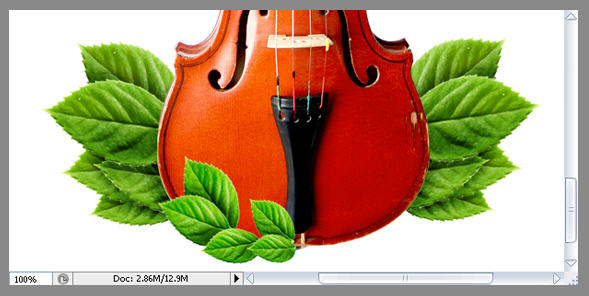 Duplicate layer group leaf-FL, and then rename the duplicated layer group to leaf-FR . Flip the leaves via menu Edit> Transform> Flip Horizontal. Place these leaves on the bottom right of violin.
Duplicate layer group leaf-FL, and then rename the duplicated layer group to leaf-FR . Flip the leaves via menu Edit> Transform> Flip Horizontal. Place these leaves on the bottom right of violin.
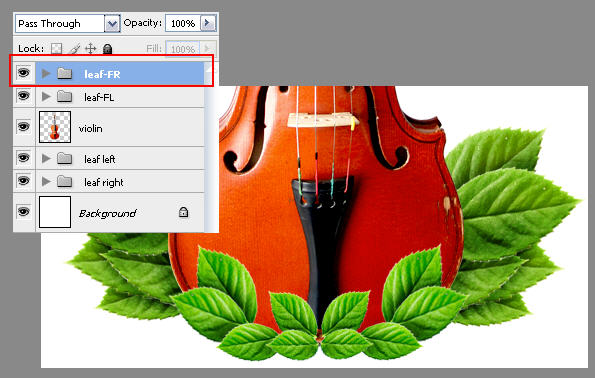
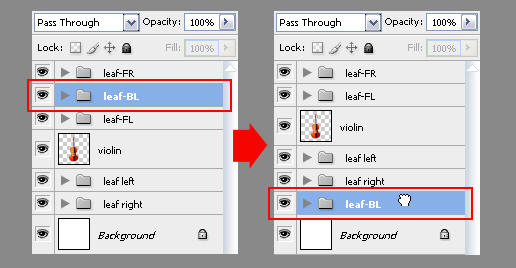 Re-arrange the leaves using Move tool and Free Transform command. Arrange the leaves’s layout like the one below. Again, redefine shadows as needed, and duplicate this group so that there are leaves along the back left and back right of the violin.
Re-arrange the leaves using Move tool and Free Transform command. Arrange the leaves’s layout like the one below. Again, redefine shadows as needed, and duplicate this group so that there are leaves along the back left and back right of the violin.
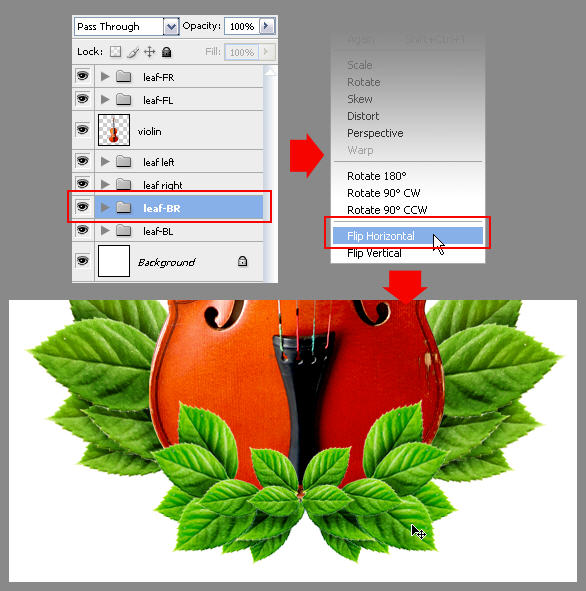
When done selecting, copy and paste the rose
image over the leaf-FR layer group. Adjust rose’s size and then place it down with the leaves.
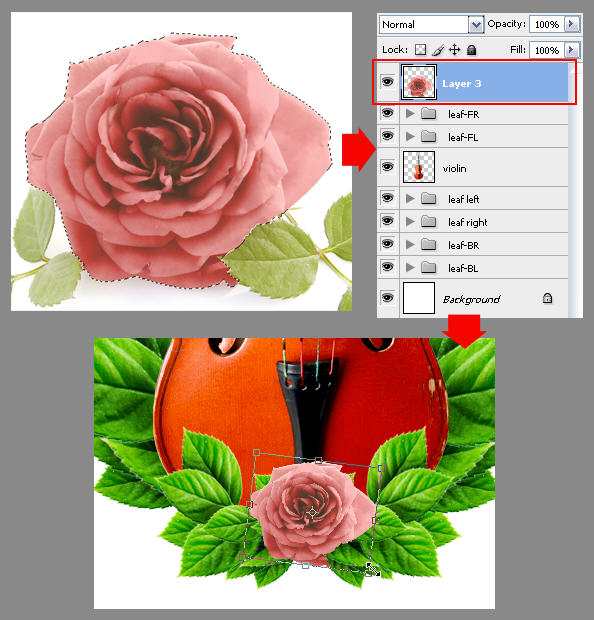 Rename layer 3 (rose’s layer) to rose. Bring up the Levels Dialogue (Ctrl+L), then adjust theinput levels value until rose’s color becomes more vibrant as shown below. If you’re not satisfied with the result, use the burn and dodge tools to bring out the shadowns and highlights in the Rose.
Rename layer 3 (rose’s layer) to rose. Bring up the Levels Dialogue (Ctrl+L), then adjust theinput levels value until rose’s color becomes more vibrant as shown below. If you’re not satisfied with the result, use the burn and dodge tools to bring out the shadowns and highlights in the Rose.
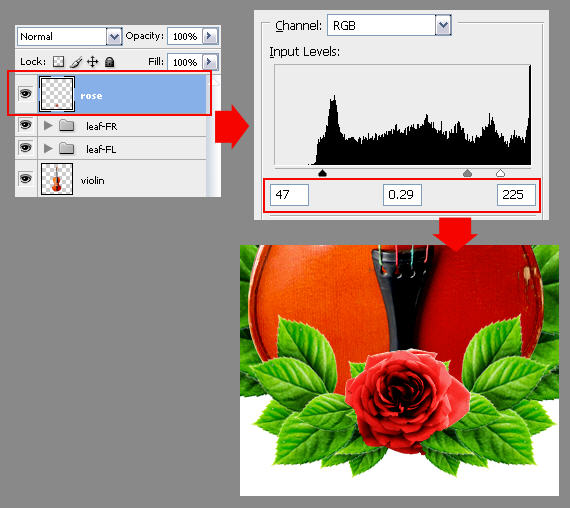
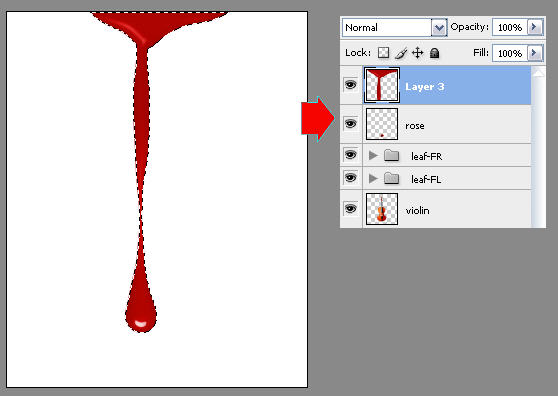 Rename layer 3 to blood. Now drag it down so it placed below rose’s layer. Adjust the blood’s size and then place it below the rose.
Rename layer 3 to blood. Now drag it down so it placed below rose’s layer. Adjust the blood’s size and then place it below the rose.
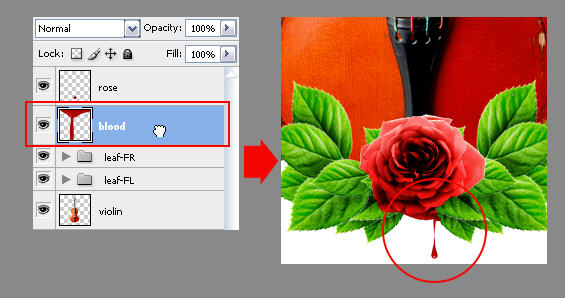
If you don’t have photoshop CS yet, expand canvas size from the Image > Canvas Size menu.

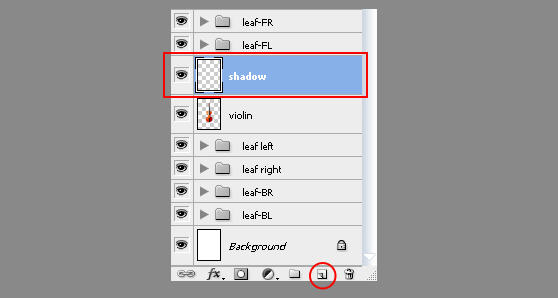 Grab the Brush tool. Pick a soft round brush with 65px diameter size. Set the Mode to Normal and reduce Opacity to 25%. Start drawing shadows for the leaves (make sure you set the foreground color to black) using the Brush tool. See the example below.
Grab the Brush tool. Pick a soft round brush with 65px diameter size. Set the Mode to Normal and reduce Opacity to 25%. Start drawing shadows for the leaves (make sure you set the foreground color to black) using the Brush tool. See the example below.
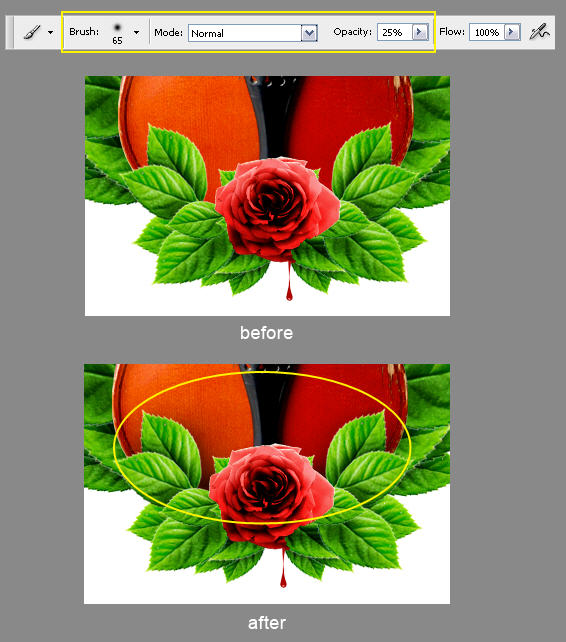
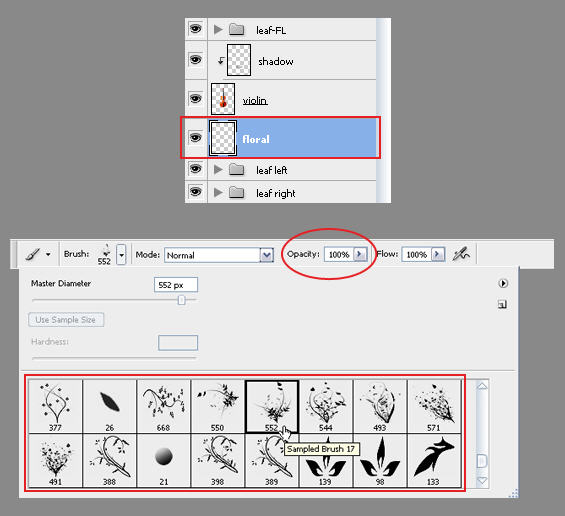 Use these brushes to create some flower shape around the violin. Vary the brush size and shape until you get a nice result.
Use these brushes to create some flower shape around the violin. Vary the brush size and shape until you get a nice result.
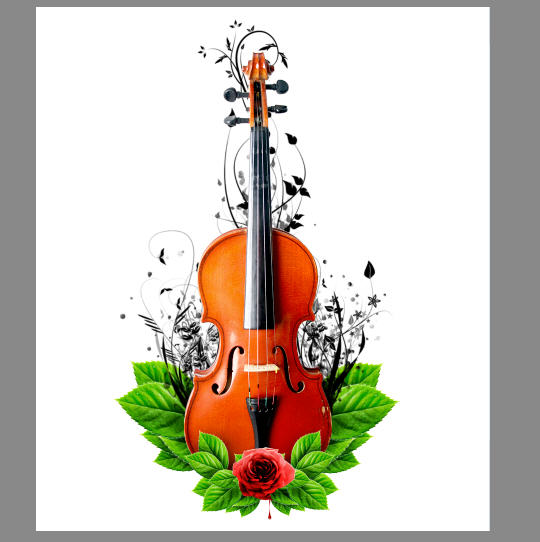
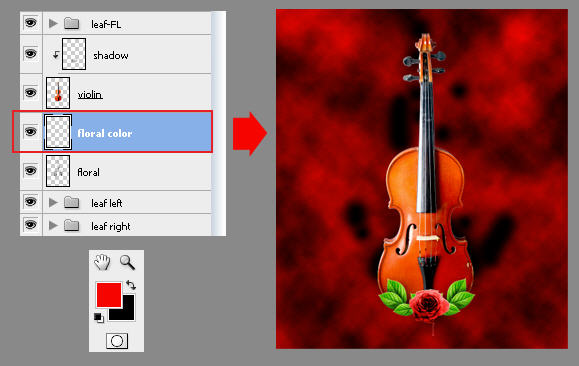 To put the clouds inside the flowery shape( floral layer ), simply press Alt+Ctrl+G (make sure you still have the floral color layer selected). Now floral color has become a clipping mask, the clouds will now appear inside the floral shapes.
To put the clouds inside the flowery shape( floral layer ), simply press Alt+Ctrl+G (make sure you still have the floral color layer selected). Now floral color has become a clipping mask, the clouds will now appear inside the floral shapes.
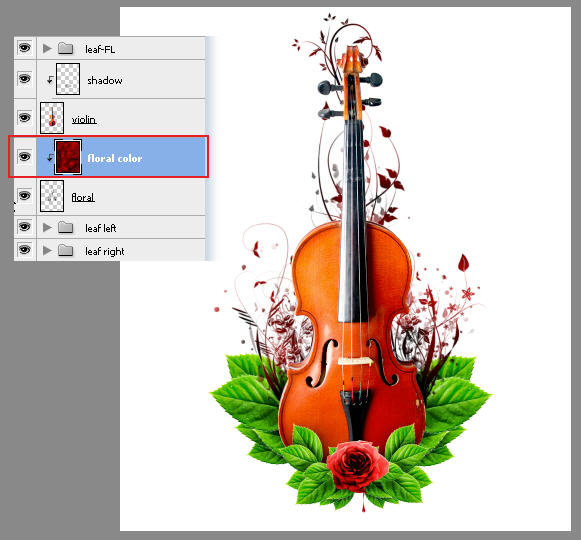


 Show the Brush Pallette by pressing F5. Then open the Brush Tip Shape option. Adjust brush Diameter to 1400px and Change the Angle to 90. Use this brush to create the crushed paper texture (still on the background layer).
Show the Brush Pallette by pressing F5. Then open the Brush Tip Shape option. Adjust brush Diameter to 1400px and Change the Angle to 90. Use this brush to create the crushed paper texture (still on the background layer).
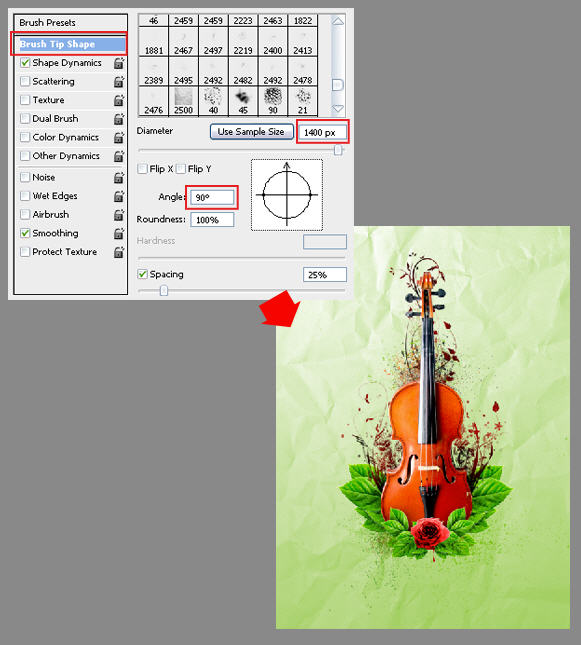

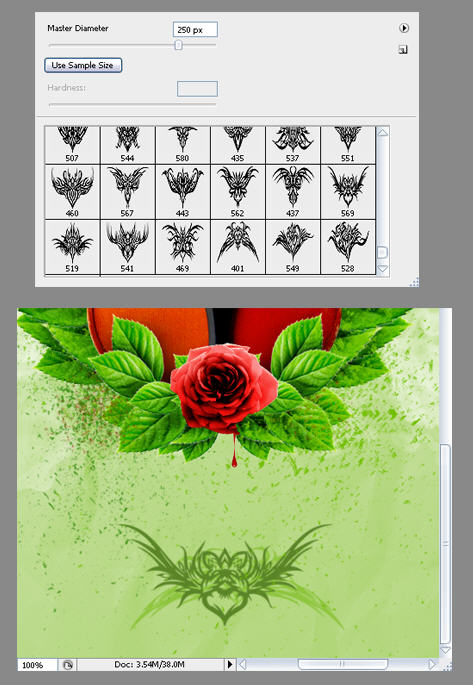
 And you’re done! Hope you enjoy the tutorial and learned something new here!
And you’re done! Hope you enjoy the tutorial and learned something new here!
Step 1: Creating a New Document
First of all, create a new document at 1000x1000px and use a white background.
Step 2: Insert The Fiddle
Make a selection around the violin image. The Easiest way to do this step is by using the Magic Wand tool ( see settings below, make sure you activate the add to Selection button (circled on left) and check the (Contiguous option). Click several times to select all of the background area, which is colored white. Then Inverse the selection (just press Ctrl+Shift+I).

Step 3: Add The Leaf Image
Open the rose image. Using Polygonal Lasso tool, create selection around the leaf. See image below.


Step 4: Color Adjustment
Editing would be simpler if we rename layers by it’s content, so feel free to do so. I’ll refer to layers by name to make things simpler from this point on. Just rename layer 1 to “violin” and layer 2 to “leaf”.Select the violin layer, then press Ctrl+L to bring up the Levels dialog. Adjust Input Levels valueas shown below to increase the contrast. Click OK when done.


Step 5: Arranging Leaves Part.1
Duplicate the leaf layer by pressing Ctrl+J. With the leaf layer copy still selected, adjust the position and rotate it right a bit. See image example below.

Step 6: Shadows and Highlights
Click the original leaf layer (It should be the bottom leaf layer). Select the Burn tool. Pick a soft round brush and adjust the brush diameter around 30 to 40 px. Reduce the Exposure value to 25%. Now use it to create shadows like shown in this example.


Step 7: Duplicating Leaves
This kind of illustration always ends with a lot of layers, so it’s a better idea to keep these layers organized within layer groups. Below, you can see the simplest way to create a layer group and rename them after.
Name the layer group duplicate’s: leaf left. With the layer group leaf left still selected, click menu Edit> Transform> Flip Horizontal, all leaf layers should be flipped to the left now. Using the Move tool, drag the layer group leaf left so the leaves are positioned on the violin’s left side.

Step 8: Arranging Leaves Part.2
Duplicate layer group leaf left, rename its duplicate to leaf-FL. Drag layer group leaf-FL over the violin layer.


Step 9: Arranging Leaves Part.3
Duplicate leaf-FL layer group once more, then rename the duplicated group to leaf-BL. Drag this layer group below layer group leaf right.

Step 10: Adding the Rose
Open the rose image again. Select the rose petals, using any selection tool you like. The fastest way is using Quick Selection tool ( available only in Photoshop CS3/CS4 ), but you can also use Magic Wand or polygonal lasso tool.When done selecting, copy and paste the rose
image over the leaf-FR layer group. Adjust rose’s size and then place it down with the leaves.


Step 11: Adding a Blood Drip
For my piece, I’d like to add some flare to the Rose with a drop of blood falling from it. Open the blood image, select it using any selection tool you like. When done, copy-paste it over the rose’s layer.

Step 12: Expanding Canvas Size
By using Crop tool, make a rectangular selection like this one below. Then adjust the control point so it’s out of the canvas. Press Enter to finish this step (only effective within Photoshop CS above). The canvas should be expanded right now.If you don’t have photoshop CS yet, expand canvas size from the Image > Canvas Size menu.

Step 13: Shadow layer
Create a new layer above the violin layer. Name the new layer “shadow”.

Step 14: Using Floral Brush
Create a new layer below the violin layer. Name the new layer to floral. Load the Suddendly Spring Brushes and make sure you set the brush Opacity back to 100%.

Step 15: Alter the Floral Color
Create a new layer between the floral and violin layer. Name the new layer to floral color. Set foreground color to red and background color to black. Then use Filter> Render> Clouds to create a red and black cloud..

Step 16: Adding Debris
Load the Debris Brush. Then Create a new layer above floral color layer (if the new layer becomes a clipping mask, simply press Alt+Ctrl+G to cancel it). Name the new layer, debris. Use the debris brushes to create some debris around the leaves and violin. For better result, vary the brush size and color so it matches the environment.
Step 17: Coloring Background
Grab the Gradient tool. From the option bar, choose foreground to background color and make sure you activate the linear gradient button. Change the foreground color to #C4DF9C and background color to white. Select the background layer, then use Gradient tool to create the gradient (drag it vertically from bottom to top).
Step 18: Adding Paper Texture
Load the Crushed Paper Brush. Pick pure pea green (#8dc63f) as the brush color.

Step 19: Adding Smoke
Load the Smoke and Ink Brushes. Pick white as the brush color. Now use it to draw some mystic smoke around the violin. If the smoke is too bright, undo your work and then try lowering the brush opacity before you draw the smoke again.
Step 20: Adding Smoke
Load the Flower Tattoos Brushes. Pick some of this brush to create an ornament below the violin. For better result, vary the brush color. You may end up like this example below.
Step 21: Adding Text
Almost done! I’m going to name my piece, and maybe you’ll choose to do the same. Using the Horizontal Type tool, add some text above the ornate markings created previously.
 Previous Article
Previous Article
